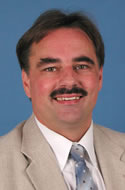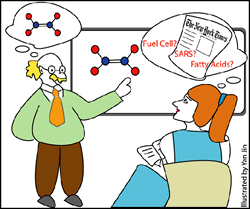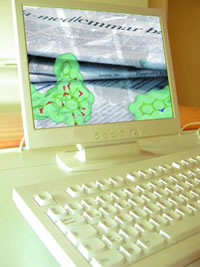|
|
Vol.
25 No. 5
September-October 2003
Science
Communication For All
The
IUPAC Committee on Chemistry Education is concerned with good
practice in chemical education at all levels and the public
appreciation of chemistry. The Committee believes that the
following article is a helpful contribution to these subjects.
The views are the author's own and are not a part of IUPAC's
strategy.
 |
|
Rainer
Glaser
|
by
Rainer Glaser
In
his Rede Lecture on The Two Cultures in 1959, Charles
Percy Snow argued that "persons educated with the greatest
intensity we know can no longer communicate with each other
on the plane of their major intellectual concern" and he concluded
that this is "serious for our creative, intellectual, and,
above all, our normal lives. It is leading us to interpret
the past wrongly, to misjudge the present, and to deny our
hopes of the future. It is making it difficult or impossible
for us to take good action." In the following decades science
progressed with political and public support. Yet, the gap
between scientific and humanistic cultures grew larger and
societal resistance to real and perceived adverse consequences
of science grew from grass-roots activism to well-organized
movements. Current concerns about science are exemplified
in a conference that The Center for Science in the Public
Interest hosts this summer in Washington, D.C., on "Conflicted
Science: Corporate Influence on Scientific Research and Science-Based
Policy."
 Fear
of science is not a recent phenomenon and it is normal in
the sense that humans approach everything new with some apprehension.
What is new, however, is that scientists now also are worried.
Martin Rees, the United Kingdom's Royal Astronomer, warns
in his book Our Final Hour how terror, error, and environmental
disaster threaten humankind's future. Such concerns were also
expressed at the National Organic Symposium of the American
Chemical Societyóheld in Bloomington, Indianaóthat
I attended and where I wrote this essay. On 10 June 2003,
Peter Schultz of the Scripps Research Institute presented
a compelling lecture on the synergistic use of biology and
chemistry to make "organisms with expanded genetic codes."
The natural amino acids and the DNA bases no longer are enough;
organisms can now be "synthesized" containing say 25 customized
amino acids or more than the usual 2 base pairs. The first
question after the talk was about possible biohazards of this
research. Had Rees known about this research, he surely would
have added a chapter to his book. Fear
of science is not a recent phenomenon and it is normal in
the sense that humans approach everything new with some apprehension.
What is new, however, is that scientists now also are worried.
Martin Rees, the United Kingdom's Royal Astronomer, warns
in his book Our Final Hour how terror, error, and environmental
disaster threaten humankind's future. Such concerns were also
expressed at the National Organic Symposium of the American
Chemical Societyóheld in Bloomington, Indianaóthat
I attended and where I wrote this essay. On 10 June 2003,
Peter Schultz of the Scripps Research Institute presented
a compelling lecture on the synergistic use of biology and
chemistry to make "organisms with expanded genetic codes."
The natural amino acids and the DNA bases no longer are enough;
organisms can now be "synthesized" containing say 25 customized
amino acids or more than the usual 2 base pairs. The first
question after the talk was about possible biohazards of this
research. Had Rees known about this research, he surely would
have added a chapter to his book.
The
Need for Engaging the Public in Science Communication
Stewart
Brand, cofounder of the Global Business Network, boldly states
that "Science is the only News . . . human nature doesn't
change much; but science does, and the change accrues, altering
the world irreversibly." Science is pervasive in all aspects
of modern society and Brand's statement captures the crucial
fact that science is growing at an incredible speed. Much
of the science important for a person's life in the 21st century
will be discovered after the person has left formal education.
The preparation of students for life-long learning has to
become more than a catch phrase, it has to become the highest
goal. From this insight derives the mandate to promote science
communication in society.
"the
press will possibly play the central role in how scientifically
driven transitions are approached and handled in the
future."
|
The
traditional intelligentsia utterly failed to recognize this
essential need and, instead, have propagated postmodernist
myths about science, which were so wonderfully exposed by
Paul Gross and Norman Levitt in their book Higher Superstition.
In his book The Third Culture John Brockman calls for
creating a culture to replace traditional intellectuals and
to communicate science and science-based philosophy. Brockman
explains in his book and at edge.org that "the third culture
consists of those scientists and other thinkers in the empirical
world who, through their work and expository writing, are
taking the place of the traditional intellectual in rendering
visible the deeper meanings of our lives, redefining who and
what we are."
In
his editorial "Public Engagement with Science" that appeared
in Science (14 February 2003), Alan Leshner wrote that
"we need to engage the public in a more open and honest, bi-directional
dialogue about science, technology, and their products, including
not only their benefits but also their limits, perils, and
pitfalls. We need to respect the public's perspective and
concerns, even when we do not fully share them (emphasis
ours), and we need to develop a partnership that can respond
to them." To do so requires informed engagement by the public
and, as Bill Moyers pointed out in his article on "Journalism
and Democracy" in The Nation (7 May 2001), "the press
will possibly play the central role in how scientifically
driven transitions are approached and handled in the future."
Are the media ready to meet this challenge? Is the public
ready to engage in science communication? The
second question probably is the critical one since the media
respond to public demands. To prepare the public for responsible
and bi-directional science communication presents a formidable
pedagogical challenge for modern college education. Can it
be met?
The
State of Undergraduate Science Education
U.S.
Census data show that in the last 35 years the number of college
age (18-24) Americans remained roughly the same, about
26 million. In the same time, the number of college students
in that age group has increased steadily from about 6 million
in 1970 to about 9 million in 2000; a 50 percent increase.
Data compiled by the Committee for Professional Training of
the American Chemical Society show that during the same time
period the numbers of M.S. and Ph.D. degrees awarded has remained
essentially the same, about 2000 degrees of each type every
year. The number of B.S. degrees fluctuated significantly;
first climbing quickly from about 8000 in 1970 to over 10
000 in 1980, then declining to less than 8000 in 1990. In
the last decade the numbers have gone up again to well above
11 000. Chemistry as a major did not gain from the added numbers
of college students, but instead barely held its ground.
The
CIITN project involves teaching chemistry to science
majors in the context of real-world issues . . .
|
Despite
the static interest in chemistry, the audience for U.S. college
chemistry education has changed dramatically. This is because
the share of young people entering college went up from 20
percent in 1970 to about 35 percent today. This is a positive
trend and broader access to education for larger segments
of society is desirable. The proportion of those required
to take chemistry has remained the same and, consequently,
chemistry instruction has become even more of a challenge
for students and for faculty.
One
of my recently retired colleagues, after perfecting his style
over 35 years of enthusiastic teaching at the University of
Missouri (MU), said on various occasions that he "cannot make
it any easier any more." A number of factors have contributed
to a gradual erosion of educational standards in college science
teaching: more students in larger classes, who represent almost
twice the percentage of that age group compared to two generations
ago; students arriving less prepared from high school; and
students exposed to a postmodernist academic climate. Simplified
textbooks, algorithmic testing of isolated and simple items,
norm-based grading, and the pressure toward grade inflation
have camouflaged this process.
There
is a dilemma here that needs to be confronted, and soon. The
problem cannot be solved via content simplification and traditional
pedagogical strategies. Reality is complex rather than simple.
There is the chemistry of the combustion of fossil fuels,
it is simple and it should be taught rigorously. The complexity
of the topic emerges in addressing environmental, economic,
and political consequences of societal energy needs. The chemistry
of pesticides is slightly more involved and it should be taught
in detail. The complexity of this and other health-related
topics emerges in discussions about what exposure levels are
considered safe for humans and the decision- making process
in establishing such levels. The chemistry of sugars, proteins,
and fats is somewhat demanding, but it is necessary to understand
the complexities of dietetics. If chemists will again dare
to teach their science in its full complexity, students will
appreciate the efforts and society will take a gigantic step
toward science communication for all!
"Chemistry
is in the News" Rises to the Challenge
 Students
need to learn to recognize and to construct these connections.
They have to be prepared to evaluate evidence, to appreciate
quantitative data, and to understand what they mean. Students
need to be able to locate additional data on their own, and
then, finally, to make judgments that are sound on many levels:
economic, political, philosophical, ethical, and moral. Just
10 years ago, any attempt at implementing systemic change
to meet such ambitious goals would have failed for lack of
access to media and information and because of problems with
course organization, management, and communication. But these
barriers no longer exist! Most universities provide phenomenal
online access to information for all students and support
for course management and communication tools. The combination
of this infrastructure with pedagogical strategies that eschew
zero-sum outcomes provide extraordinary opportunities. The
Chemistry is in the News (CIITN) project at the University
of Missouri-Columbia capitalizes on these opportunities and
prepares young citizens to comprehend and actively engage
in science communication. Students
need to learn to recognize and to construct these connections.
They have to be prepared to evaluate evidence, to appreciate
quantitative data, and to understand what they mean. Students
need to be able to locate additional data on their own, and
then, finally, to make judgments that are sound on many levels:
economic, political, philosophical, ethical, and moral. Just
10 years ago, any attempt at implementing systemic change
to meet such ambitious goals would have failed for lack of
access to media and information and because of problems with
course organization, management, and communication. But these
barriers no longer exist! Most universities provide phenomenal
online access to information for all students and support
for course management and communication tools. The combination
of this infrastructure with pedagogical strategies that eschew
zero-sum outcomes provide extraordinary opportunities. The
Chemistry is in the News (CIITN) project at the University
of Missouri-Columbia capitalizes on these opportunities and
prepares young citizens to comprehend and actively engage
in science communication.
The
CIITN project involves teaching chemistry to science majors
in the context of real-world issues and helping students connect
real-world social, economic, and political issues to the teaching
of chemistry. CIITN activities include the study, creation,
and peer review of online projects based on actual news articles
from the popular press.
Because
the CIITN project relies on online media, a taxonomy was established
of news-media-based learning activities to provide a conceptual
framework for their description (see table). Ideally, one
wants to engage students in a full range of cognitive skills.
The various levels of the CIITN project meet this challenge.
The implementation and integration of Level-1 to Level-5 of
CIITN activities has been accomplished. Students working in
small groups were exposed to news items that consisted of
an actual recent newspaper article, editorial comment, and
questions. The students studied 10 to 12 instructor- created
news items, created one news item, and reviewed a number of
student-created news items.
These
CIITN activities served several purposes. First, the activities
made connections between organic chemistry and societal issues
and explicit problems therein, and they required students
to think critically about these connections. This provided
an authentic learning task in which students were actively
engaged with the course content. Second, the activities increased
communication and interaction among students and between students
and the instructor, making a large lecture course seem less
impersonal. Third, the activities helped develop skills central
to scientific inquiry (data mining) and valuable for students'
educational and career goals (e.g., collaboration, communication,
and research). Overall, the CIITN activities create a more
effective learning environment within a large lecture course
and in doing so they promote students' learning of chemistry.
Taxonomy
of News-Media-Based Learning Activities
| Level |
Activity |
Quality
Review |
Resource |
Outcome |
|
1 |
Read
News Article |
None |
Online
news media |
Knowledge
Comprehension
Application
Analysis
Synthesis
Evaluation |
|
2 |
Read
News Items Editorial & questions |
Instructor
Review |
Online
Database & Software Tools |
|
3 |
Read
& Create News Items |
Instructor
Review |
|
4 |
Read
& Create & Judge News Items |
Internal
Peer Review |
|
5 |
Read
& Create & Judge News Items |
External
Peer Review |
|
6 |
Read
& Create & Judge News Items |
International
Peer Review |
Level-5
involves an external peer-review process in which students
taking similar courses at different universities review each
other's projects. Aside from the additional management effort,
Level-4 and Level-5 activities differ significantly: the evaluators
no longer know the evaluees, both have been instructed in
different places in slightly different ways, and, most of
all, their backgrounds and experiences may be greatly different.
Indeed, the students would benefit the most if some of the
views held by the different groups were in conflict. External
peer review contributes to the development of the students'
ability to present their own positions and hear, understand,
and respect other points of view. Hence, through Level-5 activities
students develop an appreciation of diversity and learn what
it means to be a "good citizen." In collaboration with Dr.
Susan Schelble, Level-5 CIITN activities involving inter-state
collaborations between student groups in Missouri and Colorado
were implemented in the winter semesters of 2002 and 2003.
Level-6,
which has not been implemented yet, involves border-crossing
peer review, a powerful strategy for adding a global dimension
to newsmedia- based learning activities. In this level, peerreview
results would be incorporated into the course grade and the
students would need to be aware of the international perspective
of their projects. The ultimate challenge of this level is
the requirement of international collaboration in the preparation
of the group projects. Level-6 activities present an opportunity
to help students to become "good global citizens. " The importance
of this opportunity is highlighted in Thomas Friedman's column,
published 1 June 2003 in the New York Times, in which
he explains why so many people are upset with America. His
thesis: "America has begun to touch other people's lives more
than their own governments do and therefore people all over
the world want to be able to vote on American power." Modern
Americans need to understand this aspect of being global citizens.
In
a letter to Edward Carrington, Thomas Jefferson wrote in 1787,
"The basis of our governments being the opinion of the people,
the very first object should be to keep that right; and were
it left to me to decide whether we should have a government
without newspapers or newspapers without a government, I should
not hesitate a moment to prefer the latter. But I should
mean that every man should receive those papers and be capable
of reading them (emphasis ours)." The informed citizen
is essential to democracy and, today, Jefferson's mandate
requires scientific literacy. The political goal therefore
has to be science communication for all and the most promising
strategy would involve instruction in science communication
for students in their early years of undergraduate college
education.
CIITN
has been funded by the University of Missouri System, the
University of Missouri-Columbia, The New York Times,
and The Camille and Henry Dreyfus Foundation. It is currently
funded by the Department of Undergraduate Education of the
U.S. National Science Foundation. The CIITN team includes
Dr. Rainer Glaser, professor in Chemistry at MU; Dr. James
Groccia, director of the Program for Excellence in Teaching
at MU; Dr. Susan Schelble, professor in Chemistry at the University
of Colorado-Denver; and a group of graduate studentsóMartin
Wu, John Sui, Kathleen Carson, and Brian Hodgen at MU and
Eric Lupo at UCDóthat brings exceptional interdisciplinary
breadth of talents and perspectives to the instructional design
and the assessment of the project. This team is dedicated
to affecting a systemic change in college science education
in the years to come and we are seeking international collaborators
with a shared vision and interest to play constructive roles.
We invite interested parties to contact us.
Dr.
Rainer Glaser <[email protected]>,
is a professor in the Department of Chemistry at the University
of Missouri-Columbia.
www.missouri.edu/~chemrg
http://ciitn.missouri.edu
Page
last modified 3 September 2003.
Copyright © 2002-2003 International Union of Pure and
Applied Chemistry.
Questions regarding the website, please contact [email protected]
|